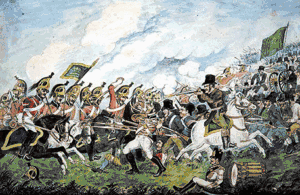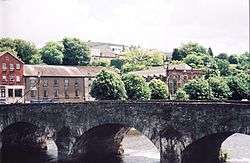Battle of Vinegar Hill
| Battle of Vinegar Hill | |||||||
|---|---|---|---|---|---|---|---|
| Part of the Irish Rebellion of 1798 | |||||||
 "Charge of the 5th Dragoon Guards on the insurgents – a recreant yeoman having deserted to them in uniform is being cut down" (William Sadler II) | |||||||
| |||||||
| Belligerents | |||||||
|
|
| ||||||
| Commanders and leaders | |||||||
|
Anthony Perry John Murphy Myles Byrne William Barker Mogue Kearns |
Gerard Lake Francis Needham William Loftus James Duff David Dundas Gen. Wilford | ||||||
| Strength | |||||||
| ~16,000[1] – 20,000 | ~13,000[1] – 18,000 | ||||||
| Casualties and losses | |||||||
| ~400[1]–1,200 dead (including camp followers)[2][3] | ~100 | ||||||
The Battle of Vinegar Hill (Irish: Cath Chnoc Fhíodh na gCaor), was an engagement during the Irish Rebellion of 1798 on 21 June 1798 when over 13,000 British soldiers launched an attack on Vinegar Hill outside Enniscorthy, County Wexford, the largest camp and headquarters of the Wexford United Irish rebels. It marked a turning point in the rebellion, as it was the last attempt by the rebels to hold and defend ground against the British military. The battle was actually fought in two locations: on Vinegar Hill itself and in the streets of nearby Enniscorthy.
Preparations
By 18 June, the British had surrounded county Wexford with between 13,000[1] and 18,000 troops and were ready to pour into Wexford to crush the insurgency. The rebel leadership issued a call to all its fighters to gather at Vinegar Hill to meet the army in one great, decisive battle. The number assembled was estimated at between 16,000[1] and 20,000, but the majority lacked firearms and had to rely on pikes as their main weapon. The camp also included many thousands of women and children who were staying there for protection against the rampaging military.
The British plan, as formulated by Gerard Lake, envisaged the complete annihilation of the rebels by encircling the hill and seizing the only escape route to the west, the bridge over the Slaney. Lake divided his force into four columns to accomplish this; three columns, under Generals Dundas, Duff and Needham were to assault Vinegar Hill, while the fourth column, under General Johnson, was to storm Enniscorthy and its bridge.
Bombardment
The battle began shortly before dawn with an artillery bombardment of Irish positions on the hill. Advance units quickly moved against rebel outposts under cover of the bombardment and moved artillery closer as forward positions were secured. The tightening ring forced the rebels into an ever-shrinking area and increased exposure to the constant bombardment, including new experimental delayed-fuse shells ( called as Shrapnel's shells; later known as shrapnel shell ) resulting in hundreds of dead and injured.[4] At least two mass charges were launched by the rebels which failed to break the lines of the military and the situation on Vinegar Hill soon became desperate for the rebels.
Attack on Enniscorthy
Meanwhile a detachment of light infantry under the command of General Johnson attacked the town of Enniscorthy but met with fierce resistance. Buildings in the town had been fortified, and the initial attack was driven back, with the loss of munitions and men. A second attack commenced with reinforcements including cavalry, which retook the lost cannon and ammunition while also incurring considerable casualties. The Irish rebels were slowly driven out of the town but managed to hold the Slaney bridge and prevent the British from crossing.[5]
Rout and atrocities

When British troops crested the eastern summit of Vinegar Hill, the rebels began to slowly withdraw through a gap in the British lines later known as "Needham's Gap", so-named because the late arrival of General Needham's troops prevented a total encirclement of the hill. Although the bulk of the rebel army escaped, many were left behind and killed in the rout phase of the battle,[2] from both cavalry and infantry attack, but also from the advanced field guns which were switched to grape shot to maximize casualties.
In addition to conventional casualties, there were also instances of rape of females amongst the rebel camp[2][6][7] and in Enniscorthy, rebel wounded were burned to death when soldiers set fire to a building used as a casualty station.[8] These atrocities may have been perpetrated in revenge for the execution by the rebels of numbers of (mostly Protestant) loyalist prisoners in the preceding weeks.[9] The Irish rebels abandoned much of the supplies they had taken from surrounding areas, and thirteen cannons were captured by the British, a number of which had been taken from the British forces previously.[10]
Aftermath

(Vinegar Hill visible in background)
Meanwhile, the bulk of the rebel force streamed unmolested towards the Three Rocks camp outside Wexford town and, following the decision to abandon the town, split into two separate columns in a new campaign to spread the rebellion beyond Wexford. One immediately set out to the west, the other northwards towards the Wicklow Mountains to link up with General Joseph Holt's forces.
The defeat was therefore not the immediate crushing blow to the Wexford rebels that it has traditionally been depicted as, but it did alter the course of the fighting as continued resistance now took the form of mobile warfare, raids, and large scale, guerilla-type operations.
Murphy was subsequently captured in Wexford and hanged.[1] Casualties for the rebels have been variously reported, with estimates ranging from 400[1] to around 1,200. Kevin Whelan estimates a figure of between 500 and 1,000 including camp followers,[2] while Archibald McLaren, a British soldier eyewitness, wrote that the Irish rebel casualties totalled about 1,200 men.[3] British casualties were around 100.
See also
_p130_Camp_on_Vinegar_Hill.jpg)
_p184_Defeat_at_Vinegar_Hill.jpg)
- Castle Hill convict rebellion, also known as the Battle of Vinegar Hill
Cultural depictions
The Battle of Vinegar Hill and the atrocities that occurred in its wake are depicted in the 2015 American musical "Guns of Ireland".[11]
References
- 1 2 3 4 5 6 7 Gardner, Juliet; Wenborn, Neil, eds. (1995). The History Today Companion to British History. London: Collins & Brown. p. 782. ISBN 1-85585-2616.
- 1 2 3 4 Reinterpreting the 1798 Rebellion in County Wexford – Kevin Whelan, p.28 in The Mighty Wave- The 1798 Rebellion in County Wexford (1996) ISBN 1-85182-253-4 (Eds. Keogh & Furlong)
- 1 2 MacLaren, Archibald. A minute description of the battles of Gorey, Arklow, and Vinegar-Hill, tegether [sic] with the movements of the army through Wicklow-Mountains, in quest of the rebels, who were supposed to have been encamped at the seven churches. ... Written by Archibald McLaren, ... [Dublin?], 1798. p 30
- ↑ The Green Flag: A History of Irish Nationalism, Robert Kee (London 1972) ISBN 0-297-17987-X, p. 121
- ↑ The British military Journal. London, UK, (1799–1801). p 230
- ↑ MacLaren, Archibald, A Minute Description of the Battles of Gorey, Arklow and Vinegar Hill; together with the movements of the army through the Wicklow mountains, National Library of Ireland, and in Charles Dickson, The Wexford Rising in 1798: Its Cause and Course, pp. 239–49 (Tralee 1955) ISBN 0-09-477250-9
- ↑ Kee, See Part 2 Chapter 10.
- ↑ Furlong, Nicholas. Fr. John Murphy of Boolavogue, 1753–98. Dublin, 1991. ISBN 0-906602-18-1
- ↑ Hamilton, Ernest W. "The Soul of Ulster"
- ↑ The chronologist of the present war; or general historical and political register: Containing a faithful series of the events which have occurred in Europe, &c. from the commencement of the French Revolution to the end of the year 1798, including a space of nearly nine years. In two parts: Part I. Amidst a variety of interesting articles will be found the following: acts (principal of Parliament) addresses assassinations battles declarations denunciations executions (remarkable) finance gifts (patriotic) inventions manifestoes motions (remarkable in Parliament) naval engagements proclamations promotions (principal) reports (of Parliament) sieges subsidies supplies treaties (of peace, offensive, defensive, and subsidiary, &c. Chronology- one of the eyes of history. The third edition, with material additions and improvements. Dublin, 1799. p 449
- ↑
Primary sources
- Byrne, Miles. (1780–1862) – Memoirs.
- Cullen, Luke. Personal Recollections of Wexford and Wicklow Insurgents of 1798 (1938).
- Cloney, Thomas. A Personal Narrative of those Transactions in the County of Wexford, in which the author was engaged, during the awful period of 1798. Dublin, 1832.
- Gordon, James B. History of the Rebellion in Ireland in the year 1798, &c. London, 1803.
- Maxwell. W.H. "History of the Irish Rebellion in 1798 with Memoirs of the Union and Bennetts Insurrection of 1803" Bell & Daldy, Covent Gardens, 1861.
Secondary sources
- Dickson, Charles. The Wexford Rising in 1798: Its Causes and Course. Tralee, 1955.
- Furlong, Nicholas. Fr. John Murphy of Boolavogue, 1753–98. Dublin, 1991. ISBN 0-906602-18-1.
- Gahan, Daniel. The People's Rising. Wexford 1798. Dublin: Gill & Macmillan Ltd., 1995.
- Kee, Robert. The Green Flag: A History of Irish Nationalism. London, 1972.
- Keogh, Daire & Nicholas Furlong (Editors). The Mighty Wave: The 1798 Rebellion in Wexford. Dublin: Four Courts Press, 1996. ISBN 1-85182-254-2.